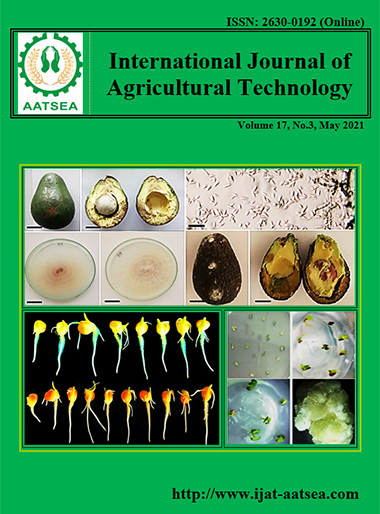Antifungal potential of some essential oils as a fumigant against a stored grain fungus, Aspergillus flavus
Main Article Content
Abstract
In the present investigation, 20 essential oils extracted from different angiospermic plant parts were screened against Aspergillus flavus. Among them, maximum percent mycelial inhibition was recorded with Chenopodium and Trachyspermum oil. Further physico-chemical properties of these two essential oils were also identified by using GLC. When MIC of these essential oil were tested, it was noted that at 100ppm act as fungistat and above 200- 400 ppm act as fungicide
Article Details

This work is licensed under a Creative Commons Attribution-NonCommercial-NoDerivatives 4.0 International License.
References
Bomfim, N. d. S., Kohiyama, C. Y., Nakasugi, L. P., Nerilo, S. B., Mossini, S. A. G., Romoli, J. C. Z., Mikcha, J. M.G., Filho, B. A. d. A. and Machinski Jr. M. (2020). Antifungal and antiaflatoxigenic activity of rosemary essential oil (Rosmarinusofficinalis L.) against Aspergillus flavus. Food Additives and Contaminants: Part A, 37:153-161.
Bosquez-Molina, E., Ronquillo-de Jesús, E., BautistaBanos, S., Verde-Calvoa, J. R. and Morales-López, J. (2010).Inhibitory effect of essential oils against Colletotrichumgloeosporioides and Rhizopusstolonifer in stored papaya fruit and their possible application in coatings. Postharvest Biology and Technology, 57:132-137.
Bull, C. T., Stack, J. P. and Smilanick, J.L. (1997). Pseudomonas syringae strains ESC-10 and ESC-11 survive in wound on citrus and control green and blue molds of citrus. Biological Control, 8:81-88.
Burt, S. (2004). Essential oils: Their antibacterial properties and potential applications in foods-a review. International Journal of Food Microbiology, 94:223-253.
Dube, S., Upadhyay, P. D. and Tripathi, S. C. (1989). Antifungal, physic-chemical and insect repellent activity of essential oil of Ocimumbasilicum. Canadian Journal of Botany, 67:2085-2087.
Dubey, N. K. (2000). Bioprospecting-option for India. Current Science, 78:369-370.
Guenther, E. (1972). The production of essential oils, p. 87: In: E. Guenther (ed.). The essential oils. Krieger Publ. Co., Malabar, Fla.
Kumar, R., Mishra, A. K., Dubey, N. K. and Tripathi, Y. B. (2007).Evaluation of Chenopodiumambrosioides oil as a potential source of antifungal, antiaflatoxigenic and antioxidant activity. International Journal of Food Microbiology, 115:159-164.
Miri, Y. B., Belasli, A., Djenane, D. and Ariño, A. (2019).Prevention by essential oils of the occurrence and growth of Aspergillusflavus and Aflatoxin B1 production in food systems: Review. DOI: http://dx.doi.org/10.5772/intechopen.88247.
Mishra, A. K. and Dubey, N. K. (1994).Evaluation of some essential oils for their toxicity against fungi causing deterioration of stored food commodities. Applied and Environmental Microbiology, 60:1101-1105.
Poppe, L., Vanhoutte, S. and Höfte, M. (2003). Modes of action of Pantoeaagglomerans CPA-2, an antagonist of postharvest pathogens on fruits. European Journal of Plant Pathology, 109:963-973.
Richard, J. L., Cole, R. J. and Archibalol, S. O. (1989). Mycotoxins, economic and health risks. Council Agriculture Science Technology Report, 116.
Rojas, T. R., Sampayo, C. A. F., Vázquez, B. I., Franco, C. M. and Cepada, A. (2005). Study of interferences by several metabolites from Aspergillus spp. in the detection of aflatoxigenic strains in media added with cyclodextrin. Food Control, 16:445-450.
Thompson, D. P. (1989).Fungitoxic activity of essential oil components on food storage fungi.Mycologia, 81:151-153.
Tzortzakis, N. G. and Economakis, C. D. (2007). Antifungal activity of lemongrass (Cympopogoncitratus L.) essential oil against key postharvest pathogens. Innovative Food Science and Emerging Technologies, 8:253-258.


